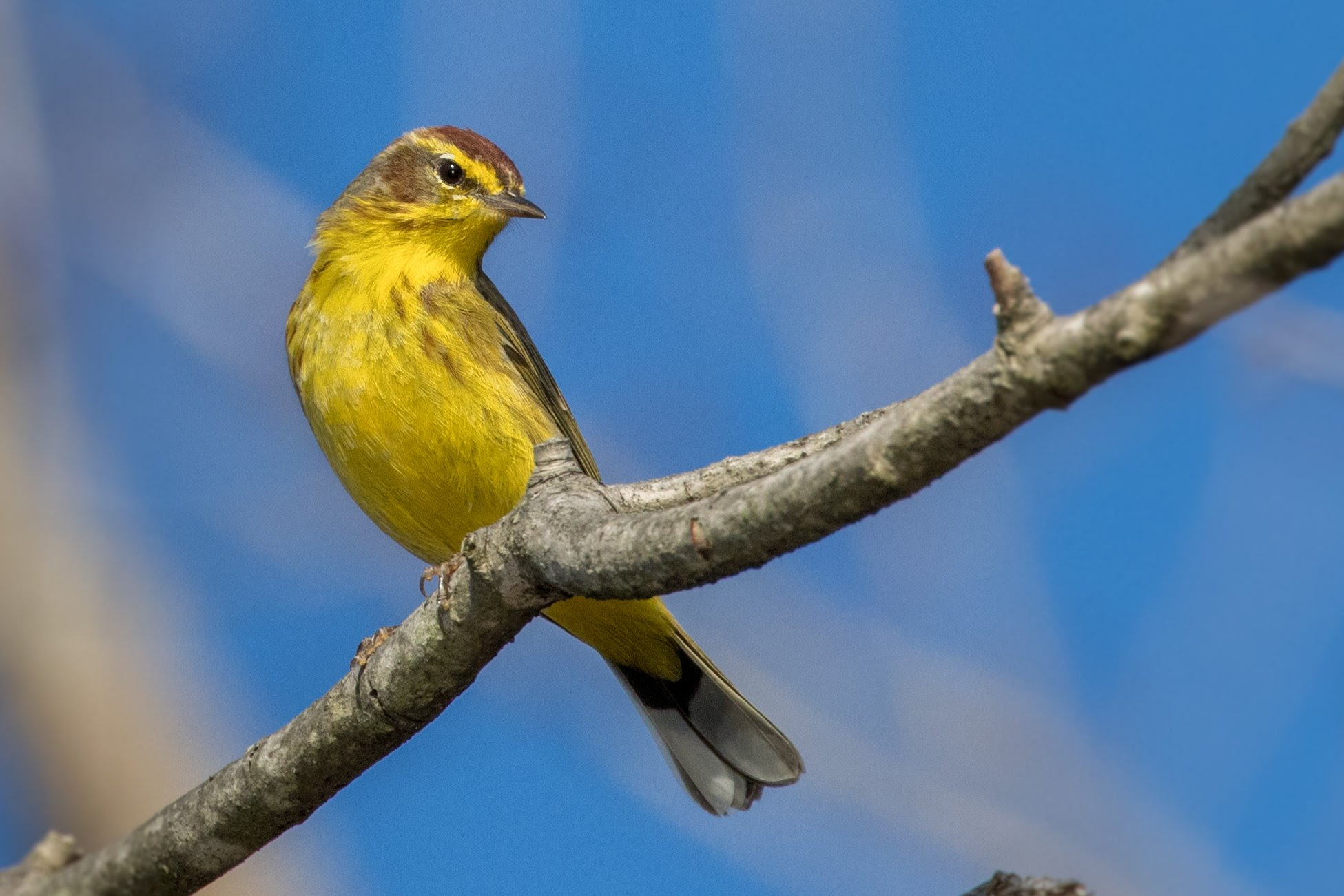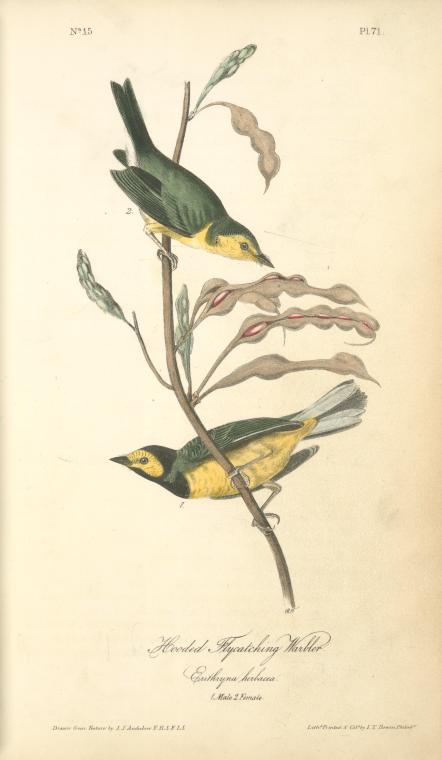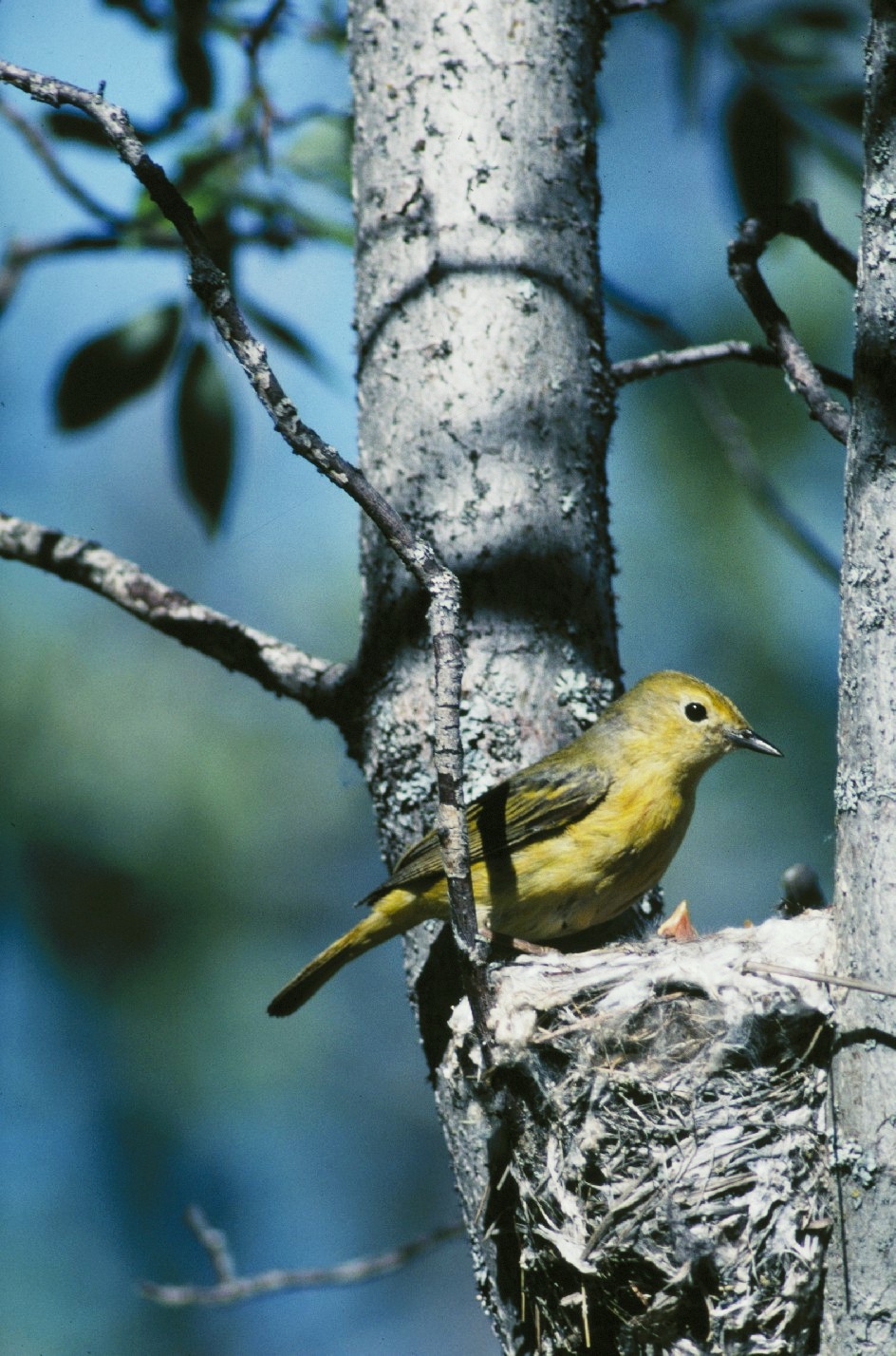|
Setophaga
''Setophaga'' is a genus of birds of the New World warbler family Parulidae. It contains at least 33 species. The males in breeding plumage are often highly colorful. The ''Setophaga'' warblers are an example of adaptive radiation with the various species using different feeding techniques and often feeding in different parts of the same tree. Most ''Setophaga'' species are long-range migrants, wintering in or near the New World tropics and seasonally migrating to breed in North America. In contrast, two ''Setophaga'' species, the palm warbler and yellow-rumped warbler, have winter ranges that extend along the Atlantic coast of North America as far north as Nova Scotia. Taxonomy The genus ''Setophaga'' was introduced by the English naturalist William Swainson in 1827. The type species was subsequently designated by Swainson in the same year as the American redstart ''Setophaga ruticilla''. The genus name is from Ancient Greek ''ses'', "moth", and ', "eating". Genetic research ... [...More Info...] [...Related Items...] OR: [Wikipedia] [Google] [Baidu] |
Cerulean Warbler
The cerulean warbler (''Setophaga cerulea'') is a small songbird in the family Parulidae. It is a long-distance migrant, breeding in eastern North American hardwood forests. In the non-breeding season, it winters on the eastern slope of the Andes in South America, preferring subtropical forests. It displays strong sexual dichromatism: Adult males have cerulean blue and white , with a black necklace across the breast and black streaks on the back and flanks. Females and immature birds have bluish-green upperparts, a pale stripe over the eye, no streaking, and are yellow below. All have two white wing bars and a thin, pointed . The cerulean warbler is insectivorous and predominantly feeds on insect larvae, though it also takes winged insects. It forages for prey and nests high in forest canopies. Individuals are strongly territorial; males will defend areas of forests. Males arrive on breeding grounds about one to two weeks earlier than females. Breeding and incubation take pl ... [...More Info...] [...Related Items...] OR: [Wikipedia] [Google] [Baidu] |
New World Warbler
The New World warblers or wood-warblers are a group of small, often colorful, passerine birds that make up the family Parulidae and are restricted to the New World. They are not closely related to Old World warblers or Australian warblers. Most are arboreal, but some, like the ovenbird and the two waterthrushes, are primarily terrestrial. Most members of this family are insectivores. This group likely originated in northern Central America, where the greatest number of species and diversity between them is found. From there, they spread north during the interglacial periods, mainly as migrants, returning to the ancestral region in winter. Two genera, '' Myioborus'' and '' Basileuterus'', seem to have colonized South America early, perhaps before the two continents were linked, and together constitute most warbler species of that region. The scientific name for the family, Parulidae, originates from the fact that Linnaeus in 1758 named the northern parula as a tit, ''Parus ... [...More Info...] [...Related Items...] OR: [Wikipedia] [Google] [Baidu] |
American Redstart
The American redstart (''Setophaga ruticilla'') is a New World warbler. It is unrelated to the Old World (common) redstart. Taxonomy The American redstart was described by Carl Linnaeus in 1758 in the 10th edition of his ''Systema Naturae'' under the binomial name ''Motacilla ruticilla''. The genus name ''Setophaga'' is from Ancient Greek σής : ''sēs'' (genitive σητός : sētós) "moth", and ', "eating". The specific ''ruticilla'' is New Latin for "redstart" from Latin ''rutilus'', "red", and New Latin ''cilla'', "tail". "Redstart" refers to the male's red tail, "start" being an old word for tail. Description The American redstart is a smallish warbler. It measures in total length and has a wingspan of . Its length is boosted by a relatively long tail and it is one of the lightest birds in its family. Weight is considerably less in winter than in summer. Males weigh an average of in summer but drop to in winter, while females drop even more from an average of ... [...More Info...] [...Related Items...] OR: [Wikipedia] [Google] [Baidu] |
Elfin Woods Warbler
The elfin woods warbler (''Setophaga angelae'') is a species of bird endemic to Puerto Rico Puerto Rico (; abbreviated PR; tnq, Boriken, ''Borinquen''), officially the Commonwealth of Puerto Rico ( es, link=yes, Estado Libre Asociado de Puerto Rico, lit=Free Associated State of Puerto Rico), is a Caribbean island and Unincorporated ..., where it is local and uncommon. Discovered in 1968 and described in 1972, it is the most recently described New World warbler (family (biology), family Parulidae). The species name, ''angelae'', is a tribute to Angela Kepler, one of its discoverers. These birds are insectivores, as they feed by gleaning (birds), gleaning small insects off the habitat leaves. Due to its small populations and restricted habitat (ecology), habitats, conservation efforts were begun in 1982 to protect this species, but as of 2005, the warbler was still in need of protection. The species is not in immediate danger as the majority of its habitat is Forest prot ... [...More Info...] [...Related Items...] OR: [Wikipedia] [Google] [Baidu] |
Hooded Warbler (60177)
The hooded warbler (''Setophaga citrina'') is a New World warbler. It breeds in eastern North America and across the eastern United States and into southernmost Canada (Ontario). It is migratory, wintering in Central America and the West Indies. Hooded warblers are very rare vagrants to western Europe. Recent genetic research has suggested that the type species of ''Wilsonia'' (hooded warbler ''W. citrina'') and of ''Setophaga'' (American redstart ''S. ruticilla'') are closely related and should be merged into the same genus. As the name ''Setophaga'' (published in 1827) takes priority over ''Wilsonia'' (published in 1838), hooded warbler would then be transferred as ''Setophaga citrina''. This change has been accepted by the North American Classification Committee of the American Ornithologists' Union, and the IOC World Bird List. The South American Classification Committee continues to list the bird in the genus '' Wilsonia''. Taxonomy The French polymath Georges-Louis Lecler ... [...More Info...] [...Related Items...] OR: [Wikipedia] [Google] [Baidu] |
American Yellow Warbler
The yellow warbler (''Setophaga petechia'') is a New World warbler species. Yellow warblers are the most widespread species in the diverse genus '' Setophaga'', breeding in almost the whole of North America, the Caribbean, and down to northern South America. Etymology The genus name ''Setophaga'' is from Ancient Greek ''ses'', "moth", and ', "eating", and the specific ''petechia'' is from Italian ''petecchia'', a small red spot on the skin. The American yellow warbler is sometimes colloquially called the "summer yellowbird". Description and taxonomy Other than in male breeding plumage and body size, all warbler subspecies are very similar. Winter, female and immature birds all have similarly greenish-yellow uppersides and are a duller yellow below. Young males soon acquire breast and, where appropriate, head coloration. Females are somewhat duller, most notably on the head. In all, the remiges and rectrices are blackish olive with yellow edges, sometimes appearing as an in ... [...More Info...] [...Related Items...] OR: [Wikipedia] [Google] [Baidu] |
Bay-breasted Warbler
The bay-breasted warbler (''Setophaga castanea'') is a small species of songbird in the New World warbler family, Parulidae. It is one of thirty-four species in the diverse genus '' Setophaga.'' Like all songbirds, or passerines, the species is classified in the order Passeriformes. Distribution Bay-breasted warblers breed in the boreal spruce-fir forests of eastern and central Canada, as well as the extreme northern United States. The species winters in the wet lowland forests of northeastern South America, the Caribbean, and southern Central America, and may be seen during spring and fall migration across the eastern half of the United States in a variety of vegetative communities. Many individuals cross the Gulf of Mexico on their long-distance migration, although some travel north and south along the Mexican shore. Diet and behavior In the breeding season, bay-breasted warblers feed primarily on insects and spiders, especially the spruce budworm (''Choristoneura fumifer ... [...More Info...] [...Related Items...] OR: [Wikipedia] [Google] [Baidu] |
Blackburnian Warbler
The Blackburnian warbler (''Setophaga fusca'') is a small New World warbler. They breed in eastern North America, from southern Canada, westwards to the southern Canadian Prairies, the Great Lakes region and New England, to North Carolina. Blackburnian warblers are migratory, wintering in southern Central America and in South America, and are very rare vagrants to western Europe. Etymology The genus name ''Setophaga'' is from Ancient Greek ''ses'', "moth", and ', "eating", and the specific ''fusca'' is Latin for brown. These birds were named after Anna Blackburne, an English botanist. Description Blackburnian warblers are small passerines and average-sized wood-warblers. They measure around long, with a wingspan, and weigh . The average mass of an adult bird is , although is slightly higher in fall due to fat reserves, averaging . Among standard measurements, the wing chord is , the tail is , the bill is and the tarsus is . In summer, male Blackburnian warblers disp ... [...More Info...] [...Related Items...] OR: [Wikipedia] [Google] [Baidu] |
Blackpoll Warbler
The blackpoll warbler (''Setophaga striata'') is a New World warbler. Breeding males are mostly black and white. They have a prominent black cap, white cheeks and white wing bars. The blackpoll breeds in forests of northern North America, from Alaska throughout most of Canada, to the mountains of New York and New England. They are a common migrant through much of North America. In fall, they fly south to the Greater Antilles and the northeastern coasts of South America in a non-stop long-distance migration over open water, averaging 2500 km, one of the longest distance non-stop overwater flights ever recorded for a migratory songbird. Rare vagrants to western Europe, they are one of the more frequent transatlantic passerine wanderers. Etymology The genus name ''Setophaga'' is from Ancient Greek ''ses'', "moth", and ', "eating", and the specific ''striata'' means "striped". Description The blackpoll warbler is a fairly small bird which attains the weight of a ball point p ... [...More Info...] [...Related Items...] OR: [Wikipedia] [Google] [Baidu] |
Adelaide's Warbler
Adelaide's warbler (''Setophaga adelaidae'') is a bird endemic to the archipelago of Puerto Rico belonging to the genus ''Setophaga'' of the family Parulidae. The species is named after Adelaide Swift, daughter of Robert Swift, the person who captured the first specimen. Description The ''S. adelaidae'' complex was originally considered a single species, with three populations occurring in Barbuda, Puerto Rico and St. Lucia. Each of these populations were regarded as a subspecies, ''S.a. subita'', ''S.a. adelaidae'' and ''S.a. delicata'' respectively. These subspecies were later elevated to species rank as the Barbuda warbler (''Setophaga subita''), the St. Lucia warbler (''Setophaga delicata'') and Adelaide's warbler. In 2011, the American Ornithologists' Union reclassified the Parulidae, which resulted in ''D. adelaidae'' being transferred to genus ''Setophaga.'' Adelaide's warbler has gray upperparts with yellow underparts. The species has a yellow line above the eye and a w ... [...More Info...] [...Related Items...] OR: [Wikipedia] [Google] [Baidu] |
Chestnut-sided Warbler
The chestnut-sided warbler (''Setophaga pensylvanica'') is a New World warbler. They breed in eastern North America and in southern Canada westwards to the Canadian Prairies. They also breed in the Great Lakes region and in the eastern United States. Etymology The genus name ''Setophaga'' is from Ancient Greek ''ses'', "moth", and ', "eating", and the specific ''pennsylvanicus'' means "Pennsylvania". Migration range These birds are migratory, wintering in Central America south to northern Colombia, with a confirmed sighting from as far south as Ecuador; they are also very rare vagrants to western Europe. They arrive in their breeding range in May and depart by mid-September. Description This species is a moderately-sized New World warbler. Despite having very different plumage, it is thought to be closely related to the widespread yellow warbler. In total, this species measures from in length and spans across the wings. Body weight ranges from . Among standard measurem ... [...More Info...] [...Related Items...] OR: [Wikipedia] [Google] [Baidu] |
Black-throated Green Warbler
The black-throated green warbler (''Setophaga virens'') is a small songbird of the New World warbler family. Description It has an olive-green crown, a yellow face with olive markings, a thin pointed bill, white wing bars, an olive-green back and pale underparts with black streaks on the flanks. Adult males have a black throat and upper breast; females have a pale throat and black markings on their breast. Measurements: * Length: * Weight: * Wingspan: Habitat and distribution The breeding habitat of the black-throated green warbler is coniferous and mixed forests in eastern North America and western Canada and cypress swamps on the southern Atlantic coast. These birds' nests are open cups, which are usually situated close to the trunk of a tree. These birds migrate to Mexico, Central America, the West Indies and southern Florida. One destination is to the Petenes mangroves of the Yucatán. Some birds straggle as far as South America, with the southernmost couple of r ... [...More Info...] [...Related Items...] OR: [Wikipedia] [Google] [Baidu] |


.jpg)

.jpg)


.jpg)


